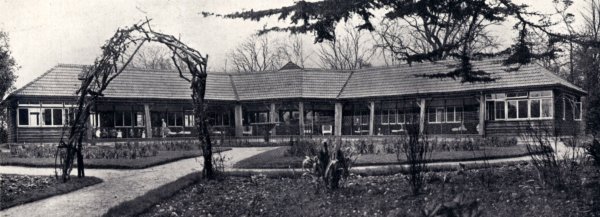The Hospital
Following the death of Lady Scott in 1909, the whole of the Great Barr Hall estate was sold off at a series of auction sales. The main sale, in October 1911, included Great Barr Hall and the associated estate.
The West Bromwich Poor Law Guardians were successful in buying the principal lot of 557 acres, comprising Great Barr Hall and Park (including Merrions Wood, all six lodges and Park Farm) for just £28,000. Park Farm with 110 acres of prime farming land was sold off shortly afterwards.
Walsall Poor Law Guardians quickly joined with their West Bromwich counterparts in a far-reaching scheme to alleviate over-crowding in the local Poor Law establishments. The first priority was the renovation of Great Barr Hall to receive infants, either orphans or the offspring of mostly unmarried mothers.

Picture courtesy Peter Allen
The first new building on the estate was Darby Home, completed in April 1914, a wooden fabrication on the French Garden site behind the Hall. It originally housed TB patients from the Poor Law infirmaries.
The building was soon converted for use as an annexe to the children's home at the Hall.
It later served as staff accommodation.
Sanders Home was opened in April 1926. It offered accommodation for children under the age of five years. A small children's unit, run on hospital lines, remained on the estate until 1932.
At the same time a separate institution for high-grade mental
defectives was taking shape on another part of the estate. It
was known as Great Barr Park Colony. The first residents moved
in just after the close of the First World War. It was built
up over the next decade to an overall horseshoe-shaped design
with the sexes separated—males one side, females the other.
Numbers quickly increased as the requirements of the Mental Deficiency Act of 1913 were met. By 1938 it was necessary to build a large number of separate buildings on the Great Barr Hall side of the estate. This ‘Male Side’ was exclusive accommodation for boys and men. Females remained on the old site which was henceworth known as the ‘Female Side.’
The whole site became known as St Margaret's in 1948, at the start of the National Health Service. The Hospital was formally closed in March 1997, although a small number of high-dependency residents remained on the estate until 2004.
These pages document its development until its closure in 2004.Much of this information has been provided by Peter Allen, chair of the Barr and Aston Local History Society who has also provided the "Century of Caring" articles which detail the development of the hospital outlined above.